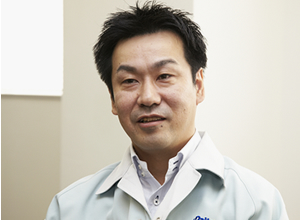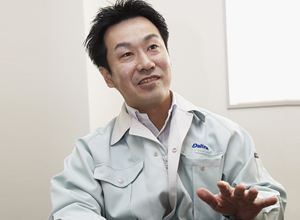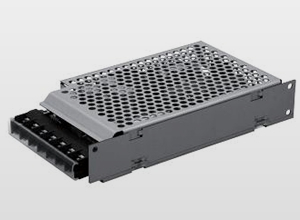
Daitron power supply devices serve their purposes in a wide range of fields from medical to industrial. Among them, the low noise switching power supply series has been attracting a great deal of attention in the industry. We spoke with the Power Supply Engineer who was tasked with this latest development, to learn about his thoughts on building this technology into products and about the future of power supply devices.

Q: First of all, what can you tell us about the switching power source? What sort of device is it?
A: Until the switching power supply made its appearance, linear power supply was the main type used. This is a power supply device made to eliminate any instability in converting the incoming voltage so as to output stable electrical power. As a result, there is a considerable loss, making it not very efficient. And then, the switching power supply made its appearance. It is designed to switch on and off in small, repeated increments, and supply stable power by controlling the on/off time in response to the conversion of the input voltage and load. It may be easier to visualize if you think of a faucet being opened and closed to adjust the force and amount of water coming out of the tap. By carefully switching the power on and off in this way, any loss of energy can be minimized while power output is stabilized.
The problem with the switching power supply is that noise is produced when the power is turned on and off. That is the reason that the dropper power supply is used in device where is very sensitive for noise. At the present time, the switching power supply is in the mainstream for its high efficiency, low cost, compact size an light weight. Still, there are not many low-noise devices, so if noise is an issue there has been no other choice but to use the dropper power supply.

Q: This must mean that the industry is eagerly seeking a way to somehow reduce noise in the switching power supply. Is there a lot of activity in that field?
A: No, the fact is that the industry has a number of manufacturers who are aiming at providing compact dimensions, low cost, and high efficiency models. For them to achieve those aims, the problem of noise continues to lurk. Since I have lots of opportunities to meet with customers, I often hear what a problem it is for them to deal with electrical noise. It became clear to us at Daitron that we could help solve those issues for our customers if we were able to develop a switching power supply that did not require users to take additional measures to avert noise. If we could reduce noise to the level of the dropper power supply, the major disadvantage of a switching power supply would disappear. This search to solve our customers' problems allowed us to approach the challenge from a different perspective than other companies, and to work on finding a way to reduce noise.

Q: What is the most difficult problem in attaining a low noise solution?
A: To be completely frank, there just is no easy way to reduce the noise. The switching power supply is an analog circuit. Everytime you touch the circuit, the volume of noise changes - so, you watch the waveform and look for the slightest changes as you work your way through, using trial and error. Everyday, you just continue to compile data, thinking that if this causes the noise to increase, then doing the opposite will make it decrease. I suppose you could say this is like imagining the flow of electricity. Still, we were faced with yet another layer of problems. Although we were able to discover a way to reduce noise, the modification would affected the cost. We couldn't simply concern ourselves with solving the noise problem as an isolated issue. Technically, it is possible to create a switching power supply with lower noise - but the feat is meaningless if the resulting product outprices any possibility of being marketable. Low noise and low cost must be achieved in tandem, so day after day we kept researching every possibility in order to come up with the best possible product.

Q: What sort of customers look for a low noise switching power source?
A: Daitron's products have been made for the customer who needs a power supply that has eliminated the averse effect of electrical noise on equipment performance. Other concerns have been to lower both the cost and the time customers needed to devote to implementing noise-cutting countermeasures; for those customers who have been using a dropper power supply in order to avert noise problems, we want to offer a more compact, more efficient solution.
There are a variety of requirements that customers have, making it hard to summarize what it is that customers are looking for. Even though the dropper power supply offers low noise, there are those who are looking for something with a smaller design. Then, there are those customers who work with measurement instruments involving minute signals; they used a switching power supply with a noise filter inserted behind it. To all those customers who were looking for improved mechanical performance or who were eager to eliminate any need for anti-noise measures, it has been very satisfying to hear their pleasure at the advances we achieved. There are even those who simply remark that it's a great power supply, and that of course never fails to make my day (chuckle). It's been a real surprise to see how much of a difference the power supply device makes in the performance of the equipment it powers. The low noise feature had been aimed at a niche market, but I think these devices have a lot of potential in them yet.

Q:What are the features of the new LFS series? What are the plans for future product development?
A: The new LFS50A and LFS150A are more efficient and smaller, as well as keeping the distinguishable feature of our switching power supply, low-noise. Our new compact switching power supply will extend the application range. We focused on minimizing noise in this time as well, since our essential motivation is to provide switching power supply considering usability from the customers' perspective.
We will keep developing better products to change the general idea of switching power supply that it emits noise.
For our next challenge, I'd like to see us find a way to add high efficiency and energy conservation into the mix, along with low noise, to contribute to the greater issue of ecological impact. Also, the improvement in power supply performance means that there can be an improvement in the performance of the product it is built into. It would give me great pleasure to have a hand in the development of machines that could brighten the future for all of us.
We're now in the midst of a change from analog to digital, and we hear that there are fewer people who are interested in designing power supplies. It's my feeling though that there is still a lot of room to grow in this field, not only from an engineering standpoint, but in terms of business too. I am only one engineer in one company, but to me, the world of power supply devices is both wide and deep, with much to explore.